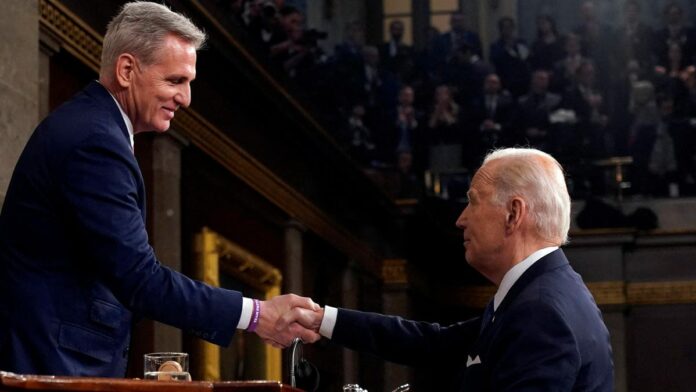The US got a step closer to enacting a deal that would suspend the federal government’s borrowing limit.
The House of Representatives yesterday (May 31) voted in favor of the Fiscal Responsibility Act to freeze the debt ceiling. The agreement that president Joe Biden and House speaker Kevin McCarthy inked after weeks of deliberation easily passed with a 314-117 majority, backed by 165 Democrats and 149 Republicans. The GOP holds a small 222-213 majority in the House.
Next, the bill heads to the Senate, which Biden urged to act quickly so he can sign the bill into law as soon as possible. It’s a race against the clock given that, without a freeze or raise in the debt ceiling, the US could fail to pay some of its obligations by June 5, risking a default, an event that would shake both the domestic and the global economy.
The agreement would cap some government spending and suspend the debt ceiling until Jan. 1, 2025. That leaves the fight to negotiate a new raise to the debt ceiling until after the 2024 presidential election.
Quotable: The Senate will vote on the debt ceiling this week
“There’s been a very good vote in the House. I hope we can move the bill quickly here in the Senate and bring it to the president’s desk as soon as possible.” —Senate Majority Leader Chuck Schumer said on May 31 to formally place the bill on the calendar for Thursday, June 1.
A brief timeline of America’s race against a potential debt default
January 19: The Treasury Department (Treasury) ran up against its $31.4 trillion debt limit and deployed emergency borrowing authority—“extraordinary measures”—to continue fully financing government operations.
May 12: The nonpartisan Congressional Budget Office (CBO) projects that “if the debt limit remains unchanged, there is a significant risk that at some point in the first two weeks of June, the government will no longer be able to pay all of its obligations.”
May 22: Treasury secretary Janet Yellen notifies Congress that the Treasury may fail to meet all the government’s obligations as early as June 1, 2023.
May 24: Fitch, one of the three major ratings agencies alongside S&P and Moody’s, warns that a failure to reach a deal could cost America its AAA grade. A downgrade in the nation’s creditworthiness means there is higher risk in buying bonds issued by that nation. That increases interest rates, and therefore a nation’s cost of issuing debt, making it less attractive to investors.
May 25: In a White House press briefing, Biden says he’s had “several productive conversations” with McCarthy, adding that the talks pertained to “outlines of what the budget will look like, not about default.”
May 26: Yellen sets the new “X-date” for default as June 5.
May 28: Biden and McCarthy reach an agreement to suspend the debt ceiling for two years.
The debt ceiling agreement has left both sides wanting
The hard-fought deal easily passed in the lower chamber of Congress, but neither party was fully satisfied with it. Both sides, conservatives and liberals, have bones to pick.
Republicans wanted steeper spending cuts but won easier approval for energy projects—including fossil fuel ones—and a new budgeting mechanism for government agencies, while Democrats have to stomach clawbacks in covid relief, new requirements for Americans to access federal food aid, and restarting student loan repayments.
The US debt, by the digits
$31.46 trillion: Current size of the US debt
$1.59 trillion: Discretionary spending cap in fiscal year 2024, a reduction of $12 billion compared to 2023, according to the House Budget Committee
7 million: People who’d be out of work in case of a prolonged default, as per Moody’s estimates. In this scenario, the US would also enter a recession
One-tenth: Share of the US economic activity threatened by a breach of the debt ceiling, according to Goldman Sachs’ estimates
78: How many times Congress has acted to “permanently raise, temporarily extend, or revise the definition of the debt limit,” most recently in 2021. Of these, 49 were implemented under Republican presidents, and 29 were under Democratic presidents.
Related stories
📜 Biden has struck a debt ceiling deal with Republicans to avoid a default
🌍 Please, DC, don’t hurt the global economy
🤑 The unnecessary debt ceiling showdown is already costing US taxpayers money


